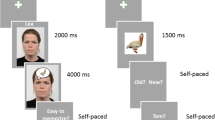Abstract
This within-subjects study investigated the effect of small enclosed spaces on human brain activation during a simple word encoding task. A small and movable wooden box was designed, inside of which participants were exposed to visually presented words while asked to decide whether or not the first and last letters of each word were in alphabetical order. Simultaneously, brain activity was recorded via EEG. Respective encoding-related brain potentials were contrasted to an open space condition with the same task instruction. Data processing revealed that brain potentials were significantly more negative going at left lateral-frontal electrode locations when participants were inside the box compared to outside.
First, we interpret this finding to show an increase in frontal brain activity reflecting higher amygdala activation while inside the box, i.e. a bottom-up process. Given the enclosed nature of this condition, one may assume fear-related brain responses to occur, reflecting projections from the amygdaloid complex to the frontal cortex. A second interpretation is that the increased lateral-frontal activity while inside the box stems from frontal regulation of negative affective responses, i.e. a top-down process, associated with the enclosed space. A third alternative interpretation is that attentional processes mediated by the anterior cingulate cortex (ACC) are active on higher levels while inside the box versus outside.
Under the assumption that the event-related potential (ERP) differences are indeed fear-related, we want to suggest a new psychological construct that is subsequently introduced as implicit claustrophobia, i.e. a non-conscious fear of enclosed spaces.
Access this chapter
Tax calculation will be finalised at checkout
Purchases are for personal use only
Similar content being viewed by others
References
Wardenaar, K.J., Lim, C., Al-Hamzawi, A.O., Alonso, J., Andrade, L.H., Benjet, C., Bunting, B., de Girolamo, G., Demyttenaere, K., Florescu, S.E., Gureje, O., Hisateru, T., Hu, C., Huang, Y., Karam, E., Kiejna, A., Lepine, J.P., Navarro-Mateu, F., Browne, M.O., Piazza, M., Posada-Villa, J., ten Have, M.L., Torres, Y., Xavier, M., Zarkov, Z., Kessler, R.C., Scott, K.M., de Jonge, P.: The cross-national epidemiology of specific phobia in the World Mental Health Surveys. Psychol. Med. 47(10), 1744–1760 (2017). https://doi.org/10.1017/S0033291717000174
Rugg, M.D., Mark, R.E., Walla, P., Schloerscheidt, A.M., Birch, C.S., Allan, K.: Dissociation of the neural correlates of implicit and explicit memory. Nature 392(6676), 595–598 (1998). https://doi.org/10.1038/33396
Kunaharan, S., Halpin, S., Sitharthan, T., Bosshard, S., Walla, P.: Conscious and non-conscious measures of emotion: do they vary with frequency of pornography use? Appl. Sci. 7, 493 (2017). 17p.
Walla, P., Koller, M., Brenner, G., Bosshard, S.: Evaluative conditioning of established brands: implicit measures reveal other effects than explicit measures. J. Neurosci. Psychol. Econ. 10(1), 24–41 (2017)
Walla, P., Endl, W., Lindinger, G., Deecke, L., Lang, W.: Implicit memory within a word recognition task: an event-related potential study in human subjects. Neurosci. Lett. 269(3), 129–132 (1999). https://doi.org/10.1016/S0304-3940(99)00430-9
Bosshard, S.S., Bourke, J.D., Kunaharan, S., Koller, M., Walla, P.: Established liked versus disliked brands: Brain activity, implicit associations and explicit responses. Cogent Psychol. 3(1) (2016). https://doi.org/10.1080/23311908.2016.1176691
Geiser, M., Walla, P.: Objective measures of emotion during virtual walks through urban neighbour-hoods. Appl. Sci. 1(1), 1–11 (2011). https://doi.org/10.3390/app1010001
Chang, M., Pavlevchev, S., Flöck, A.N., Walla, P.: The effect of body positions on word-recognition: a multi-methods NeuroIS study. In: Davis, F., Riedl, R., vom Brocke, J., Léger, P.M., Randolph, A., Fischer, T. (eds.) Information Systems and Neuroscience. Lecture Notes in Information Systems and Organisation, vol 32. Springer, Cham (2020). https://doi.org/10.1007/978-3-030-28144-1_36
Baumeister, R.F., Schmeichel, B.J., Vohs, K.D.: Self-regulation and the executive function: the self as controlling agent. In: Kruglanski, A., Higgins, E.T. (eds.) Social Psychology: Handbook of Basic Principles, 2nd edn., pp. 516–539. Guilford Press, New York (2007)
McCloskey, G., Perkins, L.: Essentials of Executive Functions Assessment. Wiley, Hoboken (2013)
Deussing, J.M., Wurst, W.: Amygdala and neocortex: common origins and shared mechanisms. Nat. Neurosci. 10(9), 1081–1082 (2007). https://doi-org.library3.webster.edu/10.1038/nn0907-1081
Suslow, T., Ohrmann, P., Bauer, J., Rauch, A.V., Schwindt, W., Arolt, V., Heindel, W., Kugel, H.: Amygdala activation during masked presentation of emotional faces predicts conscious detection of threat-related faces. Brain Cogn. 61, 243–248 (2006)
Ironside, M., Browning, M., Ansari, T.L., Harvey, C.J., Sekyi-Djan, M.N., Bishop, S.J., Harmer, C.J., O’Shea, J.: Effect of prefrontal cortex stimulation on regulation of amygdala response to threat in individuals with trait anxiety: a randomized clinical trial. JAMA Psychiatry 76(1), 71–78 (2019). https://doi.org/10.1001/jamapsychiatry.2018.2172
Davis, K.D., Hutchinson, W.D., Lozano, A.M., Tasker, R.R., Dostrovsky, J.O.: Human anterior cingulate cortex neurons modulated by attention-demanding tasks. J. Neurophysiol. 83(6), 3575–3577 (2000). https://doi.org/10.1152/jn.2000.83.6.3575
Weissman, D.H., Gopalakrishnan, A., Hazlett, C.J., Woldorff, M.G.: Dorsal anterior cingulate cortex resolves conflict from distracting stimuli by boosting attention toward relevant events. Cereb. Cortex 15(2), 229–237 (2005). https://doi.org/10.1093/cercor/bhh125
Author information
Authors and Affiliations
Corresponding author
Editor information
Editors and Affiliations
Rights and permissions
Copyright information
© 2020 The Editor(s) (if applicable) and The Author(s), under exclusive license to Springer Nature Switzerland AG
About this paper
Cite this paper
Flöck, A.N., Walla, P. (2020). Think Outside the Box: Small, Enclosed Spaces Alter Brain Activity as Measured with Electroencephalography (EEG). In: Davis, F.D., Riedl, R., vom Brocke, J., Léger, PM., Randolph, A.B., Fischer, T. (eds) Information Systems and Neuroscience. NeuroIS 2020. Lecture Notes in Information Systems and Organisation, vol 43. Springer, Cham. https://doi.org/10.1007/978-3-030-60073-0_3
Download citation
DOI: https://doi.org/10.1007/978-3-030-60073-0_3
Published:
Publisher Name: Springer, Cham
Print ISBN: 978-3-030-60072-3
Online ISBN: 978-3-030-60073-0
eBook Packages: Computer ScienceComputer Science (R0)




